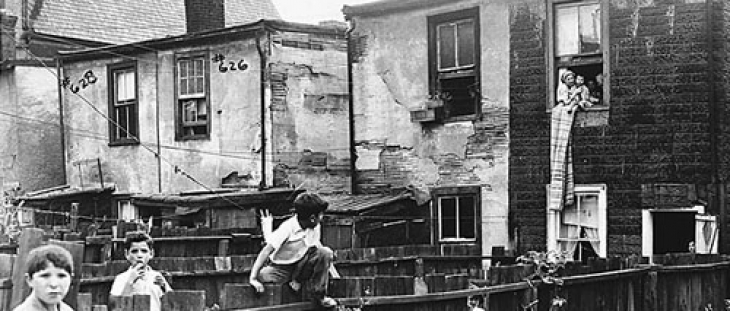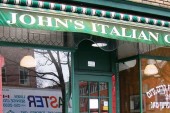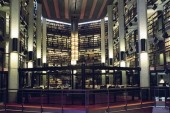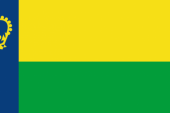
 (City of Toronto Archives) Cabbagetown is probably better known for its glorious Victorian houses and affluent residents than its cabbages these days, but vestiges of the past continue to bare significance for those in the neighbourhood. We talk to Amy Lavender Harris, geography teacher of York University and author of Imagining Toronto, about how Cabbagetown’s gentrification in the 1970s paved the way for the class dynamics that exist in the area today. Harris is giving a talk this evening entitled, “Will the Real Cabbagetown please Stand Up?: Regent Park, St. Jamestown and Cabbagetown in the Literary Imagination” from 7pm -8:30pm at Parliament branch of the Toronto Public Library. Why is there so much uncertainty about Cabbagetown’s identity? Actually, it isn’t uncertainty that clouds Cabbagetown’s identity so much as a concerted effort among resident-historians to shift Cabbagetown’s boundaries and rewrite history in a way that emphasizes architectural cohesion and suppresses social and cultural difference. This effort, which can be traced to the early 1970s when what is now called Cabbagetown first began gentrifying, has a visible history, traceable through literary and historical accounts of the neighbourhood. For most of its history Cabbagetown was considered the neighbourhood bounded by Gerrard, Parliament, Queen and River Street. Hugh Garner’s Cabbagetown, still considered the authoritative depiction of the neighbourhood, describes Cabbagetown’s streets in a way that leaves little doubt as to its location. In the abridged 1950 edition, Garner names several streets (Sackville, Sydenham, St. David) clearly associated with the area south of Gerrard. In the 1968 edition (the one most Torontonians are familiar with) he extends this mapping, going so far as to incorporate a clear schematic of the streets on the title page of the book and, in the author’s preface, describes the boundaries of Cabbagetown as being “Parliament Street on the west, Gerrard Street on the north, the Don River on the east and Queen Street on the south.” Adjacent areas, among them Moss Park and the area to the north of Gerrard, are sometimes referred to as Cabbagetown but he asserts that “this is an error.” In the text of the 1968 edition of the novel Garner adds additional street names–”Sackville, Parliament, Taylor, Oak, Sumach, Sydenham”–to further establish his local topography. Why would Garner go to such trouble to define Cabbagetown’s boundaries? In part his impulse might have been motivated by the destruction of most of Old Cabbagetown to create Regent Park, and he alludes to this in his introduction; writing that, “Cabbagetown remains only a memory to those of us who lived in it when it was a slum.” Incidentally, Garner speaks positively of Regent Park, describing it as “a godsend” to the neighbourhood. In their 1971 book Working People: Life in a Downtown Neighbourhood, a cultural analysis of the Cabbagetown area documenting a period when gentrification was beginning to alter the district’s physical landscape and social terrain, James Lorimer and Myfanwy Phillips point out that Cabbagetown’s boundaries reflect meaningful class dynamics and are therefore best understood as being both spatially and socially fluid: “People in Toronto who do not live there generally call it ‘Cabbagetown.’ Respectable residents object on the grounds that Cabbagetown is a name which refers to the area to the south of Gerrard Street, the Anglo-Saxon, working-class, low income Toronto neighbourhood most of which was demolished to make way for the Regent Park-Moss Park public housing projects. In fact, however, most city residents use the name to refer to Toronto’s Anglo-Saxon, working-class “slum” areas, and probably if they have thought about it would realize that Cabbagetown in their sense of the term moved north, south and then west as its original area was demolished.” For their part, Lorimer and Phillips decline to use the name “Cabbagetown,” acknowledging its “abusive” and pejorative connotations. Instead, they call the area “east of Parliament.” Is it unusual for such a prominent class divide to exist in the one neighbourhood? Are you aware of any other neighbourhoods in Toronto that have experienced a similar level of ‘class segregation’? Toronto–the ‘City of Neighbourhoods’–is defined largely by class divisions. Even Rosedale has a class divide, given that the smaller homes near the CPR line in what is still known as ‘North Rosedale’ even now lack the prestige of the grander homes in ‘South Rosedale.’ Indeed, in his Rosedale novel The Swing in the Garden, Hugh Hood describes growing up in North Rosedale, “the dormitory of the servants of the south.” In his short story, “Stones,” Timothy Findley describes a young girl, living on the west side of Yonge Street, whose dinner invitation is rebuffed by the mother of a girl living on the east side, on the grounds that, given the location, it “wouldn’t be appropriate.” This sort of class consciousness has faded but not erased entirely. Anyone living west of Bathurst Street who describes their neighbourhood as “Forest Hill” is likely to meet with raised eyebrows. I live in the Junction, a neighbourhood that has shifted from “gritty” to “hipster” in less than a decade. For many years real estate agents showing houses never admitted they were located in the Junction, instead describing the location as “High Park North” or the frankly arcane “Bloor West North.” For their part, Bloor West residents observed an invisible demarcation line at Annette Street, sniffing at those of us living north of that divide as if we were beyond the Pale. I am pleased to note that the Pale has shifted north to the tracks, meaning one is now ‘safe’ in a socio-economic sense as long as one lives south of Dundas. There is a WalMart located immediately north and west of this area, frequented by Junction residents who avert our eyes guiltily at the check-out counter before strapping multi-pack diapers onto our bike racks and riding off to line up for brunch at the Purple Onion. Do you think the gentrification of Cabbagetown by affluent professionals in the 1970’s had more of a positive or negative impact on the neighbourhood? The impact was immensely positive for the area north of Gerrard. Property values increased, interior decorators had free reign to experiment in one another’s living rooms, and the Victorian architecture of the district has been preserved–in part because much of it has been named a Heritage Conservation District and also because someone will nark on any property owner who dares to knock together a set of new front steps without the proper approvals. The area to the south (and, for the most part, to the west) has not benefited from this transition, largely because it has been methodically excluded from the area’s identity. People who live in Regent Park are reminded on a daily basis that they are Cabbagetown’s ‘others’ as surely as Cabbagetown’s original residents were ostracized by the rest of the city. Has Cabbagetown produced any notable literary men or women down through the years? Cabbagetown–particularly the ungentrified parts of it–has been richly imagined. Hugh Garner’s Cabbagetown is only one of the area’s notable works. There is also McAree’s Cabbagetown Store, a memoir describing the area as it was until the 1940s. Juan Butler’s Cabbagetown Diary suggests that the district hasn’t changed that much since the era depicted in Garner’s novel. Tim Wynne-Jones’ urban fantasy novel The Knot describes Cabbagetown at the cusp of gentrification, and is one of the most interesting Cabbagetown books for this reason alone. Regent Park–which I consider part of Cababgetown–has produced a number of memorable representations. Mark Thurman’s Cabbagetown Gang is set among the cracked pavements and broken glass of Regent Park, as is Deborah Ellis’ Looking For X (1999), a young adult novel about a teenaged girl living in the Project. Most recent is Rabindranath Maharaj’s Toronto Book Award-winning novel, The Amazing Absorbing Boy, whose protagonist, a 17-year-old Trinidadian immigrant, struggles to figure out what he–and the city–can possibly be. Which area in Cabbagetown in your opinion encompasses the heart and soul of the neighbourhood? Gerrard Street at Parliament is Cabbagetown to me. All the tensions of the neighbourhood manifest themselves at this corner–the discordant smells, the jumbled-up architecture, the groaning of the streetcars navigating the turn, the dollar stores and latte joints, the Audis and shopping carts and pimps and professionals–that is Cabbagetown to me.
(City of Toronto Archives) Cabbagetown is probably better known for its glorious Victorian houses and affluent residents than its cabbages these days, but vestiges of the past continue to bare significance for those in the neighbourhood. We talk to Amy Lavender Harris, geography teacher of York University and author of Imagining Toronto, about how Cabbagetown’s gentrification in the 1970s paved the way for the class dynamics that exist in the area today. Harris is giving a talk this evening entitled, “Will the Real Cabbagetown please Stand Up?: Regent Park, St. Jamestown and Cabbagetown in the Literary Imagination” from 7pm -8:30pm at Parliament branch of the Toronto Public Library. Why is there so much uncertainty about Cabbagetown’s identity? Actually, it isn’t uncertainty that clouds Cabbagetown’s identity so much as a concerted effort among resident-historians to shift Cabbagetown’s boundaries and rewrite history in a way that emphasizes architectural cohesion and suppresses social and cultural difference. This effort, which can be traced to the early 1970s when what is now called Cabbagetown first began gentrifying, has a visible history, traceable through literary and historical accounts of the neighbourhood. For most of its history Cabbagetown was considered the neighbourhood bounded by Gerrard, Parliament, Queen and River Street. Hugh Garner’s Cabbagetown, still considered the authoritative depiction of the neighbourhood, describes Cabbagetown’s streets in a way that leaves little doubt as to its location. In the abridged 1950 edition, Garner names several streets (Sackville, Sydenham, St. David) clearly associated with the area south of Gerrard. In the 1968 edition (the one most Torontonians are familiar with) he extends this mapping, going so far as to incorporate a clear schematic of the streets on the title page of the book and, in the author’s preface, describes the boundaries of Cabbagetown as being “Parliament Street on the west, Gerrard Street on the north, the Don River on the east and Queen Street on the south.” Adjacent areas, among them Moss Park and the area to the north of Gerrard, are sometimes referred to as Cabbagetown but he asserts that “this is an error.” In the text of the 1968 edition of the novel Garner adds additional street names–”Sackville, Parliament, Taylor, Oak, Sumach, Sydenham”–to further establish his local topography. Why would Garner go to such trouble to define Cabbagetown’s boundaries? In part his impulse might have been motivated by the destruction of most of Old Cabbagetown to create Regent Park, and he alludes to this in his introduction; writing that, “Cabbagetown remains only a memory to those of us who lived in it when it was a slum.” Incidentally, Garner speaks positively of Regent Park, describing it as “a godsend” to the neighbourhood. In their 1971 book Working People: Life in a Downtown Neighbourhood, a cultural analysis of the Cabbagetown area documenting a period when gentrification was beginning to alter the district’s physical landscape and social terrain, James Lorimer and Myfanwy Phillips point out that Cabbagetown’s boundaries reflect meaningful class dynamics and are therefore best understood as being both spatially and socially fluid: “People in Toronto who do not live there generally call it ‘Cabbagetown.’ Respectable residents object on the grounds that Cabbagetown is a name which refers to the area to the south of Gerrard Street, the Anglo-Saxon, working-class, low income Toronto neighbourhood most of which was demolished to make way for the Regent Park-Moss Park public housing projects. In fact, however, most city residents use the name to refer to Toronto’s Anglo-Saxon, working-class “slum” areas, and probably if they have thought about it would realize that Cabbagetown in their sense of the term moved north, south and then west as its original area was demolished.” For their part, Lorimer and Phillips decline to use the name “Cabbagetown,” acknowledging its “abusive” and pejorative connotations. Instead, they call the area “east of Parliament.” Is it unusual for such a prominent class divide to exist in the one neighbourhood? Are you aware of any other neighbourhoods in Toronto that have experienced a similar level of ‘class segregation’? Toronto–the ‘City of Neighbourhoods’–is defined largely by class divisions. Even Rosedale has a class divide, given that the smaller homes near the CPR line in what is still known as ‘North Rosedale’ even now lack the prestige of the grander homes in ‘South Rosedale.’ Indeed, in his Rosedale novel The Swing in the Garden, Hugh Hood describes growing up in North Rosedale, “the dormitory of the servants of the south.” In his short story, “Stones,” Timothy Findley describes a young girl, living on the west side of Yonge Street, whose dinner invitation is rebuffed by the mother of a girl living on the east side, on the grounds that, given the location, it “wouldn’t be appropriate.” This sort of class consciousness has faded but not erased entirely. Anyone living west of Bathurst Street who describes their neighbourhood as “Forest Hill” is likely to meet with raised eyebrows. I live in the Junction, a neighbourhood that has shifted from “gritty” to “hipster” in less than a decade. For many years real estate agents showing houses never admitted they were located in the Junction, instead describing the location as “High Park North” or the frankly arcane “Bloor West North.” For their part, Bloor West residents observed an invisible demarcation line at Annette Street, sniffing at those of us living north of that divide as if we were beyond the Pale. I am pleased to note that the Pale has shifted north to the tracks, meaning one is now ‘safe’ in a socio-economic sense as long as one lives south of Dundas. There is a WalMart located immediately north and west of this area, frequented by Junction residents who avert our eyes guiltily at the check-out counter before strapping multi-pack diapers onto our bike racks and riding off to line up for brunch at the Purple Onion. Do you think the gentrification of Cabbagetown by affluent professionals in the 1970’s had more of a positive or negative impact on the neighbourhood? The impact was immensely positive for the area north of Gerrard. Property values increased, interior decorators had free reign to experiment in one another’s living rooms, and the Victorian architecture of the district has been preserved–in part because much of it has been named a Heritage Conservation District and also because someone will nark on any property owner who dares to knock together a set of new front steps without the proper approvals. The area to the south (and, for the most part, to the west) has not benefited from this transition, largely because it has been methodically excluded from the area’s identity. People who live in Regent Park are reminded on a daily basis that they are Cabbagetown’s ‘others’ as surely as Cabbagetown’s original residents were ostracized by the rest of the city. Has Cabbagetown produced any notable literary men or women down through the years? Cabbagetown–particularly the ungentrified parts of it–has been richly imagined. Hugh Garner’s Cabbagetown is only one of the area’s notable works. There is also McAree’s Cabbagetown Store, a memoir describing the area as it was until the 1940s. Juan Butler’s Cabbagetown Diary suggests that the district hasn’t changed that much since the era depicted in Garner’s novel. Tim Wynne-Jones’ urban fantasy novel The Knot describes Cabbagetown at the cusp of gentrification, and is one of the most interesting Cabbagetown books for this reason alone. Regent Park–which I consider part of Cababgetown–has produced a number of memorable representations. Mark Thurman’s Cabbagetown Gang is set among the cracked pavements and broken glass of Regent Park, as is Deborah Ellis’ Looking For X (1999), a young adult novel about a teenaged girl living in the Project. Most recent is Rabindranath Maharaj’s Toronto Book Award-winning novel, The Amazing Absorbing Boy, whose protagonist, a 17-year-old Trinidadian immigrant, struggles to figure out what he–and the city–can possibly be. Which area in Cabbagetown in your opinion encompasses the heart and soul of the neighbourhood? Gerrard Street at Parliament is Cabbagetown to me. All the tensions of the neighbourhood manifest themselves at this corner–the discordant smells, the jumbled-up architecture, the groaning of the streetcars navigating the turn, the dollar stores and latte joints, the Audis and shopping carts and pimps and professionals–that is Cabbagetown to me.














